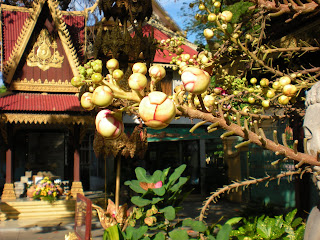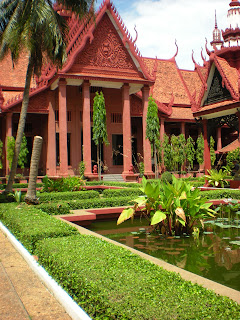One of the most sought-after destinations in Southeast Asia is Angkor Archaeological Park, just north of Siem Reap, Cambodia. The area is comprised of an extensive collection of Hindu and Buddhist temples (mostly built between the 9th and 12th century) – with the most famous being Angkor Wat, a complex that symbolizes Cambodian national identity. After arriving in Siem Reap, we bought a 3-day pass to visit the ruins, but were able to cover all of the ones we wanted to see in two days. Because the distance to and between the temples is so vast, we hired a tuk-tuk driver to take us to each of the sites from our guest house in the city. The temples of Angkor are an absolute must-see in this part of the world, so much so that most visitors to Thailand make the arduous overland journey to Cambodia just to spend a few days to see the relics of the Khmer civilization. Although there are dozens of temples throughout the park (and many more in other parts of the country), there are three primary categorizations of temples.
- The “Stars” of Angkor
The “must-see” temples of Angkor Wat, Bayon, and the ancient city of Angkor Thom are the reason most travellers make the pilgrimage to Siem Reap. For this reason, we were warned about large crowds and tour buses taking over the complexes (something that we try to avoid). To our surprise, however, we usually found ourselves alone at most of the temples that we visited, which made the experience even better. This was probably due to a combination of us trying to visit the temples when crowds tend to be at other sites (e.g. tour groups visit Angkor Thom in the morning, so we went in the afternoon), and visiting in low season. The Stars of Angkor live up to the hype – we climbed the towers of Angkor Wat, and sat in the famous “face” Indiana Jones temples at Bayon. If we had one day to visit Cambodia, seeing these two temples would definitely be at the top of our list.
 |
| Angkor Wat |
 |
| Bayon |
 |
| Bayon |
- Pyramid Temples
While the temple pyramids aren’t usually as sought after as Angkor Wat or Bayon, they were usually the most fun (and harrowing) to climb, and gave the best views of surrounding jungles and mountains. We met a friend from Vietnam on top of isolated Ta Keo, chatted with monks at the summit of East Mebon, and watched the sunset at Pre Rup. These temples are far less visited than other temples, and usually only get less attention because there is less detail to their carvings (one of Angkor Wat’s major assets). The pyramids were probably the most challenging and exhilarating temples to visit, and helped us find quiet spots away from the crowds.
3. Jungle Temples
The jungle temples at Angkor were made famous because they were in the Tomb Raider movies, and are probably the most photogenic ruins to visit. The most famous of these is Ta Promh, though there are several others, including Neak Prean, Preah Khan, and Ta Som. One of the most appealing and unique aspects of the jungle temples is that in contrast to the well-preserved Angkor Wat, Bayon, and Angkor Thom, they’re famous for their destruction by the jungle – with enormous trees slowly breaking down walls and growing through hallways. These temples best portrayed the juxtaposition between human ingenuity and the endurance of nature.
Most visitors to Angkor find the temples breathtaking, and we were no exception. Visiting the ruins was a perfect way to wrap up our time in beautiful Cambodia.


















































